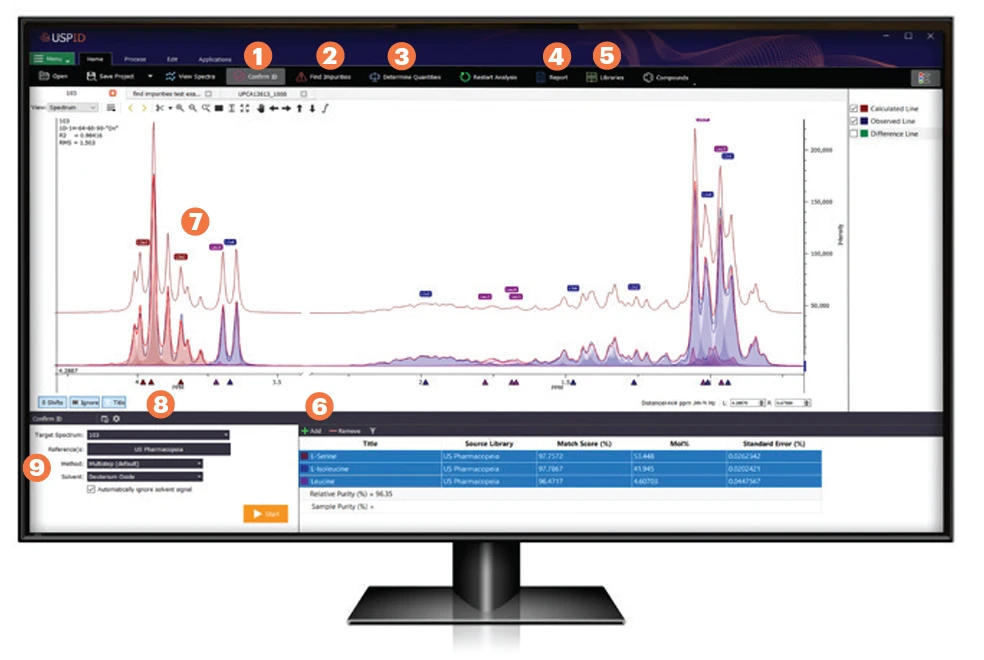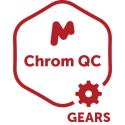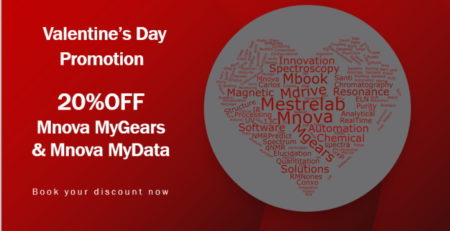Powerful qNMR analysis made easy
USP-ID software combines high-quality chemical reference databases with smart algorithms for one-click, automated solutions by qNMR, giving scientists the tools to identify and quantify complex chemical mixtures.
Benefits of USP-ID
- Easily identify chemicals and impurities – USP-ID automatically identifies, quantifies and labels a broad range of chemical components in complex mixtures. With just 10 minutes of video training NMR becomes more approachable to all.
- Resolve overlapping peaks – Improve spectral interpretability with quantum-mechanical models based on USP reference standards and smart analytics. Identify and quantify chemicals, even when no single signal is distinct.
- Customize your databases locally – Leverage USP-ID automation capabilities with drop-in support for models and databases that users create and own. USP can support with custom model development.
To learn more about NMR specifications compatible with USP-ID, download the datasheet now.

Features include:
- Automatic Chemical ID – The Confirm ID workspace enables automatic chemical identification by allowing users to screen samples against a broad library of references. Both targeted workflows where desired chemical references are selected by the user and non-targeted where no references are pre-selected by the user are supported.
- Find Impurities – Find Impurities eliminates manual spectral impurity scans by identifying and labeling signals that do not correspond to a confirmed chemical. Select a signal in the Find Impurities workspace to have it highlighted in the spectral viewer for guided spectral review.
- Automatic Quantitation – Determine quantities eliminates time consuming, manual integration of signals and enables fast quantification based on all matched signals by comparison to an internal standard of known concentration.
- Report Generator – Generate shareable PDF reports that detail the reproducible analysis steps and results. Reports contain relevant tables of matched compounds and purity values.
- Customizable Libraries – Custom Libraries are kept only on the local PC and can be used for the full range of automated NMR data analysis workflows. Drop in new custom libraries or models in the library manager.
- Information Workspace – See current analysis results from Confirm ID, Find Impurities, and Determine Quantities in the information workspace found underneath the spectral viewer.
- Automatic Peak Labeling – After Confirm ID runs, all identified peaks are automatically matched to compounds and labeled in the spectral viewer, making results easier to verify and share.
- Multi-library analysis – Select one or multiple libraries for non-targeted spectral analysis. Confirm ID can search multiple libraries simultaneously for matching compounds, including custom libraries kept only on the local PC.
- Selectable analytical methods – Different analysis methods are available for automatic chemical identification and can be selected from a dropdown in the information workspace. Users can modify and save analysis methods for future use.
USP-ID can be used with USP’s recently revised and published USP quality standards that facilitate the use of nuclear magnetic resonance (NMR) and quantitative NMR as analytical techniques, including for the control of impurities. These standards incude: USP-NF General Chapters Nuclear Magnetic Resonance Spectroscopy, and Applications of Nuclear Magnetic Resonance Spectroscopy. To further support stakeholder adoption of NMR and qNMR, USP Education offers free training and courses, including “Drug Quality Control Applications for qNMR.”
The integration of USP-ID into Mnova does not imply approval, endorsement, or certification by USP of Mestrelab products, nor does it imply that any other brand or product was judged to be unsatisfactory or inadequate. As a standard setting organization, USP avoids providing endorsements that create conflicts of interest that interfere or appear to interfere with its impartiality and objectivity.
Success Stories




















